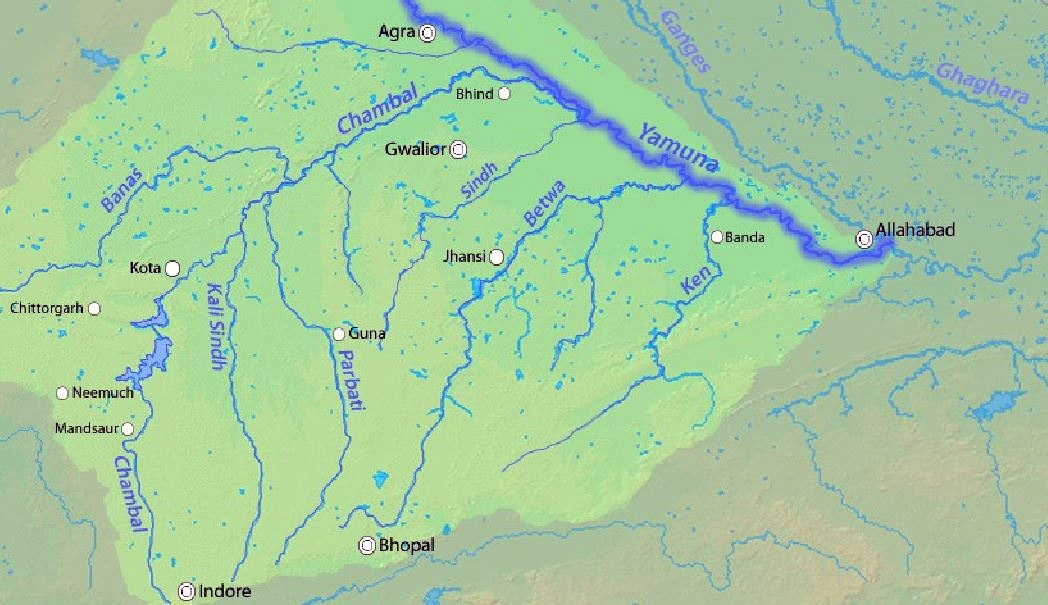Rajasthan Switch to Hindi
Banas River in Rajasthan
Why in News?
Several individuals lost their lives due to drowning in the Banas River in Rajasthan's Tonk district.
Key Points
- About Banas River:
- Location and Origin:
- The Banas River is located in the northwestern Indian state of Rajasthan.
- It originates near Kumbhalgarh in the Aravalli hills.
- Course and Flow:
- It flows northeastward onto the plains before merging with the Chambal River just north of Sheopur.
- The total length of the river is approximately 310 miles (500 km).
- Seasonal Nature and Use:
- The Banas is a seasonal river, often running dry during the hot summer months.
- Despite its seasonal nature, it serves as an important source of irrigation in the region.
- Tributaries:
- The main tributaries of the Banas River are the Berach River and the Kotari River.
- Dams:
- The Bisalpur Dam is located on the Banas River. It is a gravity dam constructed for irrigation and drinking water supply.
- A gravity dam is a dam made of concrete or masonry and withstands the pressure of water by its own weight. Its stability is entirely based on gravity.
- The Bisalpur Dam is located on the Banas River. It is a gravity dam constructed for irrigation and drinking water supply.
- Location and Origin:
Chambal River
- Chambal River originates at the Singar Chouri peak in the northern slopes of the Vindhya mountains (Indore, Madhya Pradesh). From there, it flows in the North direction in Madhya Pradesh for a length of about 346 km and then follows a north-easterly direction for a length of 225 km through Rajasthan.
- It enters Uttar Pradesh and flows for about 32 km before joining the Yamuna River in Etawah District.
- It is a rainfed river and its basin is bounded by the Vindhyan mountain ranges and the Aravallis. The Chambal and its tributaries drain the Malwa region of northwestern Madhya Pradesh.
- The Hadauti plateau in Rajasthan occurs in the upper catchment of the Chambal River to the southeast of the Mewar Plains.
- Tributaries: Banas, Kali Sindh, Sipra, Parbati, etc.
- Main Power Projects/ Dam: Gandhi Sagar Dam, Rana Pratap Sagar Dam, Jawahar Sagar Dam, and Kota Barrage.
- The National Chambal Sanctuary is located along River Chambal on the tri-junction of Rajasthan, Madhya Pradesh and Uttar Pradesh.
- It is known for the critically endangered gharial, the red-crowned roof turtle, and the endangered Ganges river dolphin.
Maharashtra Switch to Hindi
New Flatworm Species Discovered in Pune
Why in News?
A new regenerating flatworm species, Dugesia punensis, has been discovered in the Pashan Lake, Pune.
- The findings, published in the Records of the Zoological Survey of India, mark India’s first discovery of a new planarian species since 1983.
Note: Planarians are aquatic flatworms known for their remarkable regenerative abilities, earning them the title 'immortal under the edge of a knife'.
Key Points
- About Dugesia punensis:
- The species has a spotted dark brown dorsal surface and a light brown back.
- The ventral side is pale, and the eyes appear bright black, enclosed in auricular grooves.
- Body length ranges from 8mm to 12mm.
- Features include slightly reduced auricles, an elongated pharynx, and a long gonopore.
- The eggs are circular and reddish in appearance.
- Feeding and Regeneration:
- It feeds on chicken liver.
- Even after starvation for 15–20 days, the worm regenerates completely within 10–13 days.
- Researchers observed that Dugesia punensis is morphologically more delicate compared to known species.
- Ecological Significance:
- The discovery underscores Pashan Lake’s role as a vital habitat for endemic species.
- Pashan Lake is part of the Western Ghats biodiversity hotspot and serves as a critical wetland habitat.
Uttarakhand Switch to Hindi
Gangotri National Park
Why in News?
Residents of Uttarkashi district have expressed concern to the Union government over a new waste incinerator inside Gangotri National Park, located in the Bhagirathi Eco-Sensitive Zone.
Key Points
- Gangotri National Park:
- The national park was established in 1989.
- It covers an area of 1,553 square kilometers and rises to an altitude of 7,083 metres, encompassing diverse terrain.
- The park is home to the Gaumukh-Tapovan Trek, one of the most popular trekking routes in the region.
- Gaumukh at Gangotri glacier, the origin of river Ganga, is located inside the park.
- Flora: The park is enveloped by dense coniferous forests that are mostly temperate. Chirpine, deodar, fir, spruce, oak and rhododendron are the common vegetation.
- Fauna: Various rare and endangered species like Bharal or Blue Sheep, Black Bear, Brown Bear, Himalayan Monal, Himalayan Snowcock, Himalayan Tahr, Musk Deer and Snow Leopard are found in the park.
- The national park was established in 1989.
- Bhagirathi Eco-Sensitive Zone:
- In 2012, the Ministry of Environment, Forest and Climate Change (MoEF&CC) issued a gazette notification declaring the watershed area along the stretch of river Bhagirathi, covering 4,179.59 sq km from Gaumukh to Uttarkashi, an Eco-Sensitive Zone (ESZ).
- ESZs are the ecologically important areas designated to be protected from industrial pollution and unregulated development under the Environment Protection Act of 1986.
- In 2012, the Ministry of Environment, Forest and Climate Change (MoEF&CC) issued a gazette notification declaring the watershed area along the stretch of river Bhagirathi, covering 4,179.59 sq km from Gaumukh to Uttarkashi, an Eco-Sensitive Zone (ESZ).
- Revised Industry Classification by CPCB:
- In April, the Central Pollution Control Board (CPCB) introduced a new blue category under revised industrial classifications.
- This category includes essential environmental services such as waste-to-energy plants and integrated sanitary landfills to manage urban waste responsibly.
- In April, the Central Pollution Control Board (CPCB) introduced a new blue category under revised industrial classifications.
- Legal and Environmental Concerns:
- Violation of Laws: The incinerator's location violates the principles of environmental protection, as industries in such sensitive areas are prohibited.
- According to the Solid Waste Management Rules, 2016, the construction of landfills in hilly areas is strictly forbidden, and waste should be transferred to suitable locations in the plains.
- Impact on Biodiversity: The Gangotri National Park is part of the Western Ghats biodiversity hotspot, rich in unique flora and fauna.
- The presence of the incinerator in such a sensitive region exacerbates the risk of ecological degradation.
- Public Opposition: Local activists and residents have voiced strong objections, highlighting the delicate ecological balance of the Gangotri region.
- They argue that the establishment of such a facility in the Himalayas poses a significant threat to the area’s biodiversity, which is already vulnerable due to its unique and sensitive environment.
- Violation of Laws: The incinerator's location violates the principles of environmental protection, as industries in such sensitive areas are prohibited.
Central Pollution Control Board (CPCB)
- CPCB is a statutory organisation and was constituted in 1974 under the Water (Prevention and Control of Pollution) Act, 1974.
- CPCB was also entrusted with the powers and functions under the Air (Prevention and Control of Pollution) Act, 1981.
- It serves as a field formation and also provides technical services to the Ministry of Environment and Forests and Climate Change of the provisions of the Environment (Protection) Act, 1986.
Uttar Pradesh Switch to Hindi
Sant Kabirdas Jayanti 2025
Why in News?
The Prime Minister paid tribute to Sant Kabirdas on the occasion of his 648th birth anniversary, observed as Kabirdas Jayanti (Kabir Prakat Divas).
Key Points
- Historical Background:
- Kabirdas Jayanti falls on the Purnima Tithi (Full Moon Day) of the Jyeshtha month in the Hindu calendar.
- Sant Kabirdas was a 15th-century poet, saint, and social reformer, born in 1440 in Varanasi, Uttar Pradesh to a Hindu family but was raised by a Muslim weaver couple.
- He sought spiritual guidance from teachers such as Ramananda and Sheikh Taqi, shaping his unique philosophy.
- Philosophy, Works, and Teachings:
- He was a notable figure in the Bhakti movement, which emphasised devotion and love for the divine.
- The Bhakti movement started in the 7th century in South India and spread to North India during the 14th and 15th centuries.
- He founded the Kabir Panth, a spiritual community that continues to have a large following.
- His key literary contributions include Bijak, Sakhi Granth, Kabir Granthawali, Anurag Sagar.
- He composed numerous Bhajans and dohas (couplets) that condemned superstition and promoted social reform, free thinking, and spiritual unity.
- His works, written in the Brajbhasha and Awadhi dialects, significantly influenced Indian literature and the development of the Hindi language.
- He was a notable figure in the Bhakti movement, which emphasised devotion and love for the divine.
- Death and Symbolic Legacy:
- Kabirdas passed away in Maghar (UP) in 1518, where a conflict arose between Hindus and Muslims over his last rites.
- Saint Kabir’s legacy is honoured by both communities, with a samadhi built by Hindus and a mazaar built by Muslims standing side by side.


.png)








.png)


.jpg)



 PCS Parikshan
PCS Parikshan





